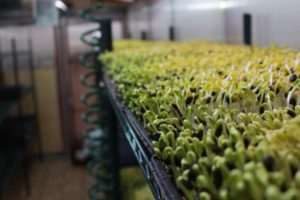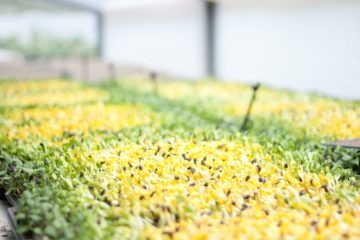One of the biggest challenges microgreens growers can have is marketing their products. There are many approaches to marketing, and you should try try to utilize them all, but we have here one of the Best Microgreens Marketing Strategy frameworks which incorporates multiple marketing approaches into one – without having to pay for advertising.
This approach focuses primarily on restaurants and grocers and applies to cafes, juice bars, and other similar retailers as well.
Best Microgreens Marketing Strategy
There are many approaches to marketing any product, including paid advertising. But you can do a lot of great marketing without paying for any advertising which can also help you build relationships with potential customers. This approach to marketing is going to require you to put in a lot of hours, but it will pay off in many ways. This approach will require some investment, but will have a longer-lasting impact than advertising. Paid advertising is only effective when you are paying for it, so when paid campaigns run out they no longer benefit you.
This approach to microgreens marketing has multiple goals:
- Increase YOUR BRAND’S awareness among potential customers

- Increase YOUR awareness and knowledge of potential customers
- Strengthen your overall ONLINE PRESENCE
- Connect you DIRECTLY with potential customers to make a sale
This microgreens marketing strategy has three basic stages:
- Establishing an online presence
- Using that presence to bring attention to your business and engage with potential customers online
- Connecting directly with potential customers
Best Microgreens Marketing Strategy
The ultimate goal here is to create an impression with potential customers online to facilitate future in-person engagement. You really want to get you product into the hands of potential customers and an online presence give you wide reach with little effort, then over time your in-person efforts will target high-quality (but higher effort) connections made online. The general idea behind this approach is that when you reach out to customers directly they already have a good awareness of who you are from your online interactions – they know your brand, your story, and your products – and they learned it from you directly, not from a paid advertisement.
In taking this approach you will be benefitting over advertising in a few ways:
- You will connect with customers directly, not through an advertisement which requires payment to be maintained
- You gain knowledge of your customers as much as they gain knowledge about you
- You are in control of who you reach out to, resulting in high-quality connections
This microgreens marketing strategy takes place in multiple steps – many of which you may already be doing, but we will go over things in detail here for those of you just getting started. The process is grouped in “order” here, but these steps can also take place out of order:
STAGE 1: Establish Your Online Presence
1. Set up your website and optimize for SEO
2. Set up a Google My Business page
3. Set up social media accounts and create good-quality content
Best Microgreens Marketing Strategy
STAGE 2: Engage with Potential Customers Online
4. Follow any social media accounts that could be potential customers
5. Regularly like, comment, and engage with potential customers’ posts
6. Email or message customers to make direct contact
7. Keep a record of contacts you have made
Best Microgreens Marketing Strategy
STAGE 3: Engage with Customers in the Real World
8. Take samples to potential customers you engaged with online
9. Follow up
10. Be patient!
There are a few things to keep in mind with this approach, which will help you see it through in the long run:
- Some potential customers are actively looking for new products or menu ingredients, so when those items come to them, they really appreciate it! Engaging with these potential customers usually result in a quicker sale.
- Some potential customers are interested in your product, but are not quite ready for it at the moment. Restaurants, for example, often have a fairly consistent menu that does not change much, so adding new ingredients is not always easy. Engaging with these potential customers usually results in future sales.
- Some potential customers don’t even know they are potential customers yet! For many folks, microgreens are still new so they are not as familiar with them. Engaging with these potential customers usually results in future sales – sometimes far in the future.
So this marketing approach is considering customers now AND in the future.
Now, let’s take a look at the steps of the best microgreens marketing strategy in more detail.
Best Microgreens Marketing Strategy Steps
STAGE 1: ESTABLISH YOUR ONLINE PRESENCE
1. Set up your website and optimize for SEO
While social media is very important, you also need a good website. Setting up a website can be a lot of work, but here are some key things you need to consider:
- To make things easier to start, use a platform like Shopify or WordPress to quickly and easily set up a stylish site that is commerce-ready. These platforms come with free and paid templates that can help get your website live in minutes – literally.
- Domain name: pick something that is relevant and do not use the default domain name that comes with your website package.
- Make sure you use a relevant site title, meta description, and keywords – keeping in mind that as a microgreens business you are almost always targeting a very local audience. So be sure to use geographical keywords.
- Utilize free SEO optimization tools such as ubersuggest, SEMRush, ahrefs. All of these tools offer great features for no cost and advanced features for paid accounts.
- Use SEO plugins such as AIOSEO and Yoast SEO on WordPress to help improve your SEO ranking.
- Use lots of great images on your website to show the beauty of microgreens and the professionalism of your set up. But don’t make it all about microgreens – include yourself and others in photos as well! Potential customers often want to know about you as much as they want to know about your products.
- Make sure your website tells the “story” of your business – what is your origin story?
- Make sure potential customers can easily contact you through your website and can connect to your social media accounts.
- Regular blog posts can give your customers real-time updates on what you are growing and improve your SEO. They also help you reflect on the work you are doing and leave useful records!
- Connect your website to Google Analytics to track website visits.
- Connect your website to Google Search Console to see what search terms are getting people to your site.
This is just a quick overview of some of the things you can do, but is a great start to ensuring your website looks professional and shows up on Google searches.
2. Set up a Google My Business page
Google’s My Business page is great for promoting local businesses. You can have a page fully set up in 15 minutes and you can even list your products. This page shows up on both Google Searches and in Google Maps searches.
3. Set up social media accounts and create good-quality content
Social media accounts allow you to interact with potential customers in real time – allowing them to learn about you and you to learn about them. Currently, Facebook and Instagram are popular social media platforms but you can also benefit from a presence on platforms like TikTok and LinkedIn Even if there are platforms you are not going to use or don’t want to use, setting up an account on them and securing your name can be of benefit if you want to use that platform in the future. Like your website, your social media accounts should all have relevant names.
These platforms are only effective if you use them regularly and post good-quality content. Use social media to tell stories and to promote products, but do so in a way that can catch your audience’s attention.
It won’t take long to recognize the handful of themes that show up in most microgreens posts:
- Healthy eating
- Local food
- Home-based business
- Change of career
- Growing setups and shelves
- Etc…
You can use these ideas to promote your products to your local market. But you can also gain a reputation among other microgreens growers by creating unique posts and showing off your system.
There are lots of great social media guides online that can help you shape relevant posts. But, as I am sure you will see, great images tend to make the best posts! Use a range of hashtags with every post to reach a wider audience than just your followers. Folks follow hashtags as well as other accounts.
Now that you have established your online presence, you can start engaging and reaching out to potential customers.
Best Microgreens Marketing Strategy
STAGE 2: ENGAGE WITH POTENTIAL CUSTOMERS ONLINE
4. Follow any social media accounts that could be potential customers
While the goal of social media is often to gain more followers, following others allows you to get to know potential customers as well. Try to follow high-quality accounts and don’t just follow people for the sake of it! Your target audience is potential customers:
- Restaurants
- Cafes
- Juice Bars
- Wholesalers
- Grocers stores, especially locally owned
You can also identify high-quality potential customers through hashtags. This can include individuals’ accounts with themes like:
- Healthy living
- Juicing
- Wheatgrass
- Living foods
Since you can follow hashtags as well as accounts, find the hashtags to follow that relate best to microgreens in your area.
You can also benefit from following other microgreens growers – this is great way to learn other ways to grow and market your crops. It can also give you ideas on what to post, though try to find angles about microgreens that others are not taking.
5. Regularly like, comment, and engage with potential customers’ posts
Once you follow a potential customer, you will want to engage with them. However, you don’t want to overdo it! One of the things that makes this the best microgreens marketing strategy is that it takes an easy approach to engaging with customers. Coming on too strong with promoting your products can really turn a lot of potential customers off (and Instagram doesn’t like it and could freeze your account!).
Here are three basic ways you can engage with other customers through posts: best microgreens microgreens strategy
- Liking potential customer posts
- You don’t need to like every one of their posts, but try to like their posts regularly. This will ensure your name starts showing up in their feeds in one way or another.
- Commenting on potential customer posts
- Your comments should be genuine
- Your comments can be a great way to first introduce your products to a potential customer, but don’t force it. You can use some more general comments first; then, when it seems right, you can post something like “Our radish shoots would make a great garnish for that dish!” Or, even getting a bit more bold, “Our radish shoots would make a great garnish for that dish – would you like us to bring you a sample?”
- Tagging potential customers in YOUR posts can draw them to your account even if they are not following you
As you engage with customers watch for signs of them engaging back through the same techniques you used above.
6. Email or message potential customers to make direct contact
Once you have regularly engaged with a potential customer online you can reach out more directly. You can do this by messaging them through social media or directly by email. Keep you messages brief, leaving more detailed messages for follow ups. Keep your first direct engagement short and sweet. Some points to consider: best microgreens marketing strategy
- Tell them who you are
- Give them an overview of your products AND your service
- Mention something about their business to show you are paying attention to them as well – future cross promotions can be mutually beneficial
- Let them know you want to bring them samples and try to find our from them the best days and times to do so!
Keep in mind, whoever you are interacting with on social media may not be who meet in person. Make sure you know who you are meeting and what their role is.
7. Keep a record of contacts you have made
It can be useful to keep a record of contacts you have made – even just recording when someone likes one of your posts. In the early days this can help you identify high-quality potential customers to engage with first.
You can use Google sheets to create a record keeping spreadsheet, noting the date and method of contact or engagement.
Best Microgreens Marketing Strategy
STAGE 3: ENGAGE WITH POTENTIAL CUSTOMERS IN THE REAL WORLD
Now that you have spent some time getting to know your customers online, you can start engaging with them in the real world!
8. Take samples to potential customers you engaged with online
One of your ultimate goals is to get your products in the hands of potential customers, and one of the best ways to do that is by taking them samples. Here are a few tips for offering samples to restaurants and grocers:
Restaurants
- Be generous with your samples – if you want a chef to get familiar with your products they’ll need more than 25 grams!
- Delivery time: Don’t show up at dinner or lunch! Try to establish a time with a chef beforehand, but often between 2:00 and 4:00 is a good time
- Bring relevant literature. If a chef decides pretty quickly they want to make an order, you need to be able to facilitate that. Some things you should let them know:
- Full product list
- Pricing
- Delivery days and times (and make sure you stick to these)
- Invoicing and payment terms
Grocers
Grocers are a bit different than restaurants as they are reselling your product. So here are a few things to keep in mind:
- See what other microgreens products they are carrying, if any
- Find out what kind of mark up they aim for on their products so you can better understand their selling price relative to your selling price
- Find out if they require any certifications from you. This is more common with larger grocery chains
- Discuss invoicing and payments – in some situations you can set the terms, in other situations you need to bend to the stores’ terms
- Discuss “buybacks” – or you buying back unsold products. Do your best to avoid this! This is easy to avoid by doing multiple deliveries each week, allowing you to adjust delivery volumes as needed
- Discuss shelf position and any display info you may have to accompany your products
Grocers usually require UPC codes on the products they carry, so be prepared to add those to your packaging
With both grocers and restaurants you should be having ongoing conversation about your products and how to keep them coming! But be sure you can maintain any commitments you make, A great general rule, is under promise and over deliver. But your service quality may be just as important as your product quality in maintaining your customers.
9. Follow up
You might get a standing order after one visit or you may have to do multiple visits and emails with potential customers before you get a sale. Be sure to stay connected with potential customer after your first in-person contact and continue to engage with them online. Remember, your products may not be right for a potential customer now, but could be perfect in the future.
Here are a few things to keep in mind:
- Very few people will be as excited about microgreens as you are, so chill out!
- Chefs have also sorts of fresh, local, small-business-based products to choose from – so you may need to get in line and wait your turn
- Customers will come and go, so the regular follow ups help new customers come as existing customers go
- Don’t over do it, folks don’t like to get harassed
10. Be patient!
It can be easy to get discouraged after visiting two dozen potential clients and not getting a single sale! But remember, you are always laying the groundwork for the future. It is important to be reaching out to potential customers all the time. In fact, in any small to medium-sized city, every potential customer you could reasonably service should know who you are!
Best Microgreens Marketing Strategy
And there you have it – a collection of tips to help you get started with marketing your microgreens business.
Best Microgreens Marketing Strategy
Oh, and get into your local farmers market as well!



0 Comments